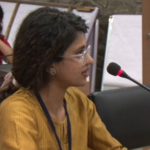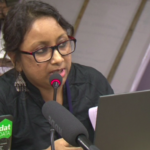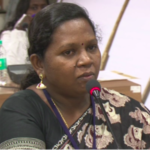Session 3. Laws and law enforcement: Caught between old rights, new violations?
Part 1
In India, the legal provisions that can be invoked in cases of gender-based cyber violence fall under two main laws: the Indian Penal Code and the Information Technology Act. The Indian Penal Code is a pre-digital law steeped in paternalism and moral censorship, with an inadequate grasp of the new manifestations of gender-based violence. As a business-oriented law, the Information Technology Act is gender neutral and marred by a piecemeal approach to gender-based violence. Through an examination of case histories and a critical reading of specific sections of these laws, this two-part session demonstrated challenges for law and law enforcement in ensuring access to justice for victims of gender-based cyber violence.
Speakers
Anu Swaraj and Nargees Basheer, National University of Advanced Legal Studies, Kochi
Amrita Vasudevan, IT for Change, Bengaluru
Srijan Sandip Mandal and Sreeparna Chattopadhyay, Srishti Institute of Art, Design and Technology, Bengaluru
Chair
Justice Prabha Sridevan (retd.), Madras High Court, Chennai
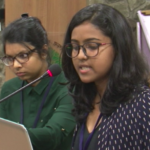
Anu Swaraj and Nargees Basheer, National University of Advanced Legal Studies, Kochi
Through three case studies of gender-based cyber violence, the paper presented an analysis of how things play out for women victims of gender-based cyber violence who approach law enforcement agencies. The first case was that of a young woman whose ex-partner threatened to publish photos of them together, when she entered the movie industry. He then proceeded to post the photographs online, without her consent. The next case was that of an actress who called out a veteran male actor for misogynistic dialogues in a movie. She was then trolled and abused online, and even received rape threats. The third case involved the morphing and subsequent online sharing of the photograph of a woman who had participated in a political march.
These three women cited stigma and reservations from family as a deterrent in filing a formal complaint. In the cases of morphing and ‘revenge-pornography’ examined by the paper, the women who were targeted were viewed as instigators of the violence, who had ‘invited it upon themselves’. Interviews with law enforcement officials revealed that the police are largely unaware of cyber-laws. Police officials feel that harm is more observable where the offense is manifestly physical and are more willing to investigate offenses with material consequences as evidence gathering is easier.
To improve access to justice in cases of gender-based cyber violence, the paper recommended setting up special investigative teams, introducing online filing of First Information Reports, establishing special courts, appointing government pleaders who exclusively attend to cyber crimes and making some cyber offenses non-bailable.
Amrita Vasudevan, IT for Change, Bengaluru
There is a need to unpack how law enforcement agencies react to technology and technology mediated gender-based violence in order to devise an effective strategy for better enforcement. In IT for Change’s ethnographic study of cyber cells in the city of Bengaluru, it was found that law enforcement officials stress the need for women’s self-policing in digital spaces. They also indicate a preference for adopting platform-provided solutions and advise victims to use measures such as blocking abusive Facebook/ WhatsApp contacts or phone numbers.
While those who report financial fraud were seen as genuine victims, those who report gender-based cyber violence (such as non-consensual circulation of intimate images) were seen as “victims of their own lack of common sense”. The perception of technology as an equalizer between men and women was used to brush off the severe underreporting of gender-based cyber violence seen in official crime records. Some police officials also felt that the IPC cannot be invoked for cyber crimes “as it applies only when the body is implicated”. This view is based on an assumption that the cyber is not about the real. Given that the Information Technology Act (IT Act) does not cover certain actions like secondary dissemination of intimate images, case registration by the police often ends up as a function of the perceptions of individual police officials and their proclivities for creative application of the IPC to cyber crimes.
It may be true that both the IPC and the IT Act have become more progressive after recent amendments that locate the crux of criminality in the violation of consent. However, even consent needs to be problematized, since limits on circulation and re-use are impossible to fix in cyber space.
A difficulty that often crops up in the prosecution of perpetrators of gender-based cyber violence is the production of digital evidence. Victims are often afraid to hand over personal devices for evidence collection, fearing uncontrolled exposure of personal information to law enforcement. Another hurdle in recovering evidence is that platforms like Facebook and WhatsApp do not always cooperate with law enforcement agencies, claiming that they lie outside the jurisdiction of the courts. If digital evidence is not collected carefully, it is disallowed from being produced in court. In this regard, it becomes extremely important to draw up guidelines for the collection of digital evidence to maintain its integrity so that it is produceable in court.
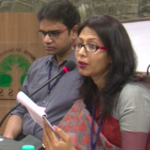
Srijan Sandip Mandal and Sreeparna Chattopadhyay, Srishti Institute of Art, Design and Technology, Bengaluru
Digital misogyny represents a continuum of offline violence spilling over to online spaces. A study by Amnesty International on the effect of gender-based cyber violence on women observes a chilling effect, with 76% of women surveyed and who had experienced gender-based cyber violence changing the way they used social media post the incident.
The Indian legal system currently does not recognize gender-based hate speech. Even international instruments such as the International Covenant on Civil and Political Rights do not recognize gender as a ground for hate speech. It was only in 2015 that the European Commission against Racism and Intolerance recognized sex, gender, sexual orientation and gender identity as grounds for hate speech.
The Law Commission of India and the T. K. Viswanathan expert committee were set up in 2017 to make recommendations on criminalizing hate speech, including online manifestations of hate speech. In their recommendation, both entities propose alternate language for the hate speech section that recognize sex, gender identity and sexual orientation as legitimate grounds for hate speech. However, the wording of the alternate section is very vague. Further, it borders on what may be unconstitutional with regard to online speech, going by the precedent set by Shreya Singhal vs. Union of India. Further the expert committee also chose to incorporate the standard of ‘incitement of offense’, a much lower threshold for hate speech compare to ‘incitement of violence’.
There is a need to move away from colonial framings of the law that subjugates the citizen, to an acknowledgment of hate speech as discrimination. This delimitation is necessary in order to correctly identify and capture what constitutes hate speech.
Open discussion
Justice Prabha Sridevan synthesized the key threads from speaker presentations and brought together reflections around strengthening legal responses to gender-based cyber violence and building capacities of law enforcement officials.
– The law has been largely androcentric and women’s perspectives have hardly ever been the determinant of statutes, even those legislations which are obviously women-centric. The aim should be for a gender equal, not merely, a gender neutral, law. Opponents of gender equality use gender neutral laws to further a fallacy that the law treats everyone equally.
– The police may be unaware of legal provisions, but they also do not wholly understand cyberspace or its dangers.
– There have been landmark judgments around consent and violence against women in India. We have come a long way from the Mathura case, which presumed consent when there were no signs of resistance, to Farooqui, which dealt with continuity of consent once given. In the case of the digital, where there is uncontrolled dissemination of information, a legal framework that presumes intention or mens rea could perhaps be justified given the nature of the medium. Each time that a non-consensual image of a woman is shared, there is a fresh act that infringes upon her right. A new jurisprudence for the digital is required that does not impinge on fundamental rights. One must also remember that the more detailed a statute is the more rigid it becomes and so escaping liability is also easier. Similarly, having more criminal laws may not be the answer in a country where the judicial system is not effective.
Comments from the floor
1. In Denmark, in an instance where a private video was shared multiple times without consent, based on a case filed by the woman who was affected, a thousand teenagers were arrested for sharing the clip. The woman now feels that more harm than good has been done by such arrests, as it led to considerable public attention. This case exhorts reflection on what should be the limits of ‘culpability’ and standards of ‘due diligence’ imposed by the law to ensure that justice is served to the woman. It is important for the law to be able to limit culpability to a rational point, but it is also important that knowledge of consent be active as well as constructive. This standard of due diligence can ensure that images are not forwarded casually, and at the same time de-limit persons upon whom such an obligation may fall so that we do not end up in a situation where a thousand people are arrested.
2. Through mergers and acquisitions, digital platforms are becoming monopolistic and powerful, but their accountability is limited. India is in the midst of addressing this vexatious issue of platform liability, especially in cases of gender-based cyber violence.
In the Sabu Mathew case on pre-natal and pre-conception sex determination advertising and in Re: Prajwala Letter on circulation of videos of rape online, the Supreme Court held platform intermediaries such as Google, Facebook etc liable for setting up pre-filtering mechanisms for such manifestly unlawful content. In the latter case, the court has also established a committee with private sector and state representatives to make recommendations as to how violent and discriminatory content can be taken down.
3. Making all offenses non-bailable may not be the best way forward, in a country that has a low threshold for punishing dissent.
Part 2
Tahmina Rahman and Zakir Uzzaman Khan, Article 19, Bangladesh
Molly Ghosh, Barrackpore Rastraguru Surendranath College, Barrackpore
Smita Vanniyar, Point of View, Mumbai
B. Radha, Manonmaniam Sundaranar University, Tirunelveli
Chair
Kiruba Munuswamy, Advocate, Supreme Court of India, New Delhi
Tahmina Rahman and Zakir Uzzaman Khan, Article 19, Bangladesh
According to available statistics, 73% of the women online in Bangladesh have experienced some form of violence. Internationally, it has been well-established that offline rights must be respected online as well. The United Nations General Assembly resolution (2013) on women human rights defenders acknowledges that tech-mediated violence is a growing concern and is a manifestation of gender based discrimination. In Bangladesh, there are a number of laws that deal with violence against women. Though the majority of these legal provisions do not directly deal with online violence, the judiciary, however, has acted with foresight.
The Supreme Court of Bangladesh has established guidelines on sexual harassment in the workplace and educational institutions. These guidelines recognize certain forms of technology-mediated violence against women. Nevertheless, there are glaring gaps in the law that must be addressed. For example, non-consensual circulation of sexual images in Bangladesh is very common, but there is no legal provision that directly criminalizes it. There are also no laws on cyberbullying and cyberstalking. There have been proposals to include technology-mediated violence against women in the proposed Digital Security Act, but this has not been accepted.
A greater awareness on the court’s guidelines on sexual harassment and guidelines on the issue of online sexual harassment are much needed. Further, the Evidence Act must be amended to include the production of digital evidence in court, which will go a long way in ensuring access to justice for victims of gender-based cyber violence.
Molly Ghosh, Barrackpore Rastraguru Surendranath College, Barrackpore
In the paper presented, Molly, draws upon primary research in West Bengal on the response of law enforcement officials to cases of gender-based cyber violence. On-ground interviews reveal that the usual advice provided by police officials to a complainant is to block and ignore the abuser instead of pursuing the case. Police officials find recovering evidence cumbersome, if the abuse takes place on a platform like Facebook and so citing lack of evidence, the police close the case.
Many a time, instead of filing a First Information Report that needs to be followed up by investigation, police are found to make only general diary entries.
National Crime Records Bureau statistics reveal that from 2011-2016, the state of West Bengal has recorded an improvement in the reporting of cyber crimes. However, these numbers are still very insignificant. Further, cyber crimes against women form a minuscule percentage of the total cyber crimes reported. Only six cases were filed under Section 66E of the IT Act, which deals with voyeurism and surreptitious capture, publication, or transmission of intimate images. There are only five cyber crime police stations for the whole of West Bengal and so, cyber crimes are usually filed in general police stations.
The law itself is limited. For instance, Section 66E of the IT Act only deals with bodily privacy. There is no recognition of informational privacy. Hence, the law does not cover cases where a women’s mobile number is posted on WhatsApp groups or on pornographic sites with the intention of harassing her.
Smita Vanniyar, Point of View, Mumbai
Section 67 of the IT Act is an anti-obscenity law, which prohibits the publishing, transmission or dissemination of lascivious material which can deprave or corrupt. In analyzing media reports on Section 67A, it is observed that crimes that are actually a violation of consent are often filed instead as crimes of obscenity. For example, distribution of videos of rape is a violation of consent at multiple levels. But such cases tend to be filed under the anti-obscenity provision – Section 67A of the IT Act – rather than consent-based provisions, as in Section 66E of the IT Act.
Section 66E is one of the least used Sections of the IT Act. Similar observations hold with respect to instances of circulation of intimate images without the consent of the victim. Other cases that are not legally recognized as violation of consent but are indeed consent violations such as morphing or the transmission of sexually explicit images or text without the receiver’s consent, are also being filed under anti-obscenity provisions. Section 67A is also slapped against people exchanging consensual sexual content.
Just as Section 66A of the IT Act was misused, Section 67A is now being used to criminalize political and artistic speech, even when there is no obscenity involved. In some situations, Section 67A is being used to book online harassment. While this may be seen as a positive use of the Section, it is also problematic because it creates a hierarchy of harassment in which sexual harassment ranks higher than other kinds of harassment.
B.Radha, Manonmaniam Sundaranar University, Tirunelveli
Students’ access to Information and Communication Technologies (ICTs) is progressively increasing. In the state of Tamil Nadu, the government has initiated a scheme to give students free laptops, which has contributed to this increase. Students also want to spend money to access the Internet, which is used for a variety of purposes including communication, self-expression, seeking information etc. Families feel a loss of control and are threatened by use of mobile phones by adolescents.
With respect to violence online, it usually occurs through the mobile phone or social media. Threats online can have severe psychological impact on female students who tend to become withdrawn, not being able to share such incidents with or seek support from their parents. Colleges lack supportive complaints mechanisms. Female students who face violence via social media sites sometimes leave the platform altogether. In these cases, neither the victim nor the perpetrator are aware of any legal provisions. Gender sensitization at a mass level is required so that women are able to participate in public spaces online and these are not usurped by men alone.
Open discussion
The chair, Kiruba Munuswamy, pointed out that pining down jurisdiction and consequently designating the state police in charge of investigation is complicated in the case of cyber crimes, as perpetrator and victim may be in different locations. Women are forced to shuttle between states just to get their complaints registered. With Section 66A of the IT Act struck out from the statute books, police are refusing to file complaints of online abuse altogether.
While speaking of gender-based cyber violence, experiences of those facing intersectional discrimination, such as dalit women, must be accounted. Police have, in certain instances, refused to file cases of gender-based cyber violence that involve a caste dimension, under the Scheduled Caste and Scheduled Tribe (Prevention of Atrocities) Act. Sensitization and training of law enforcement in cyber violence agencies is extremely important.

Comments from the floor
1. Police officials have been very selective in enforcing the law. In most cases of gender-based cyber violence, they ask the complainant to pursue the platform to take down content, whereas with respect to political dissent, they often take action even before a complaint is filed.
2. Even though Section 66E of the IT Act is a consent based provision, it is not multilayered, as there is an automatic conflation of capture and dissemination. This Section covers only situations where no consent was given for filming. It however does not cover cases where consensually filmed content is shared without consent. In these cases, the police may choose instead to apply section 67A of the IT Act, in order to get a conviction.
3. Law enforcement officials are usually well acquainted with Section 67 of the IT Act, but section 66E of the IT Act is so disregarded that police officials are not able to recall it. In such a situation, when it comes to filing a First Information Report, the former section is more likely to be applied.
4. Practicing lawyers have observed that digital evidence has actually shrunk the space for argumentation, and often ends up stalling cases where evidence does not meet the standards set by the Evidence Act.
5. Many schools across the country choose to ban the use of mobile on premises rather than work with students towards positive use. This constant supervision of students forces them to use technology surreptitiously, away from prying eyes.
